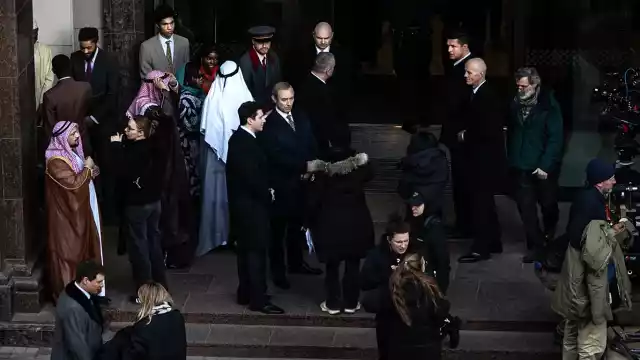LONDON — It's safe to say that relations between Russia and England have had many ups and downs since the English sea captain Richard Chancellor, on a mission to discover a northeast passage to the Orient, found himself stranded at the mouth of the Northern Dvina River in 1553 and was then escorted to the court of Moscow under Ivan the Terrible.
A new exhibition, "Treasures of the Royal Courts: Tudors, Stuarts and the Russian Tsars," at the Victoria and Albert Museum in London seeks to explore the first two centuries of the diplomatic and trade relationships that began with that encounter.
The exhibition is the result of an ongoing cooperation between the London museum and Moscow's Kremlin Museums. Another exhibit that arose out of this collaboration, "The Golden Age of the English Court," was displayed at the Moscow Kremlin Museum from October 2012 until January.
That the relationship between the two institutions is burgeoning is clear from the remarks of Tessa Murdoch, curator of the exhibition at the Victoria and Albert Museum, and Yelena Gagarina, director of the Moscow Kremlin Museums, who both highlighted their mutual satisfaction with the collaborative process when speaking at the exhibit's preview.
"This exhibition is the result of a productive exchange with the Moscow Kremlin Museums and a dialogue between the two museums that has been ongoing for nearly a decade now," Murdoch said.
In this spirit, Murdoch credited her colleague from Moscow, Olga Dmitriyeva, with motivating the quest to bring some rarely seen English artifacts into public view for this installation, such as a lesser-known portrait of Elizabeth I.
As well as this rarely exhibited painting, many other unique, exemplary items are among the more than 150 objects on display. A suit of armor worn by Henry VIII, loaned by the Royal Collection, confirms the monarch's legendary ample girth. A hand-colored map of Moscow from 1570 shows a Western assessment of Ivan IV's territories and the surrounding regions.
The literature of the era is represented by the first folio of Shakespeare's works, no less, and there is an assortment of portraits and miniatures of eminent English and Russian figures of the times, as well as lithographs depicting the various ceremonial banquets and receptions they attended as part of court life.
The exhibition's centerpiece is undoubtedly a collection of silverware gifts given to successive tsars in the 16th and 17th centuries and held in the Kremlin Armory since that time.
This treasure trove includes the fantastically ornate "Dolphin Basin," created in 1635 by Christiaen van Vianen, a preferred silversmith of Charles I and Charles II, as well as an array of other finely crafted metal vessels.
It is a tribute to the custodians of the Moscow Kremlin Museums that these precious objects still exist. Since silver is a commodity that is easily melted down and reused to manufacture weapons or coins, such a fate would almost certainly have been met by these artifacts had they been available to the treasury of England during the Civil War. Instead, their survival provides firm evidence of the importance attached to gift-giving as the rituals of diplomacy between the two countries developed.
Perhaps the most extraordinary example of the gifts presented to the Russian court on behalf of an English monarch is the chariot given to Tsar Boris Godunov in 1604.
State-of-the-art in comfort and splendor for the time, this remarkable coach was considered too fragile to be transported from the Kremlin Armory. However, a replica model and an accompanying film demonstrate the intricate carving and lavish upholstery that came with a top-end vehicle of the 17th century.
Tudor, Stuart and early Romanov history may seem a remote subject to some, but the exhibition, apart from dazzling with the sheer quality of the objects on display, does prove the point to all that England and Russia have had a complex political and social relationship for more than four centuries now.
Though Elizabeth I turned down Ivan IV's marriage proposal 400 years ago, it is fully evident that the cultural courtship between these two nations continues to bear fruit to this day.
The "Treasures of the Royal Courts: Tudors, Stuarts and the Russian Tsars" runs until July 14 at the Victoria and Albert Museum in London. A related exhibition is also planning to tour Russia during the "Russia-U.K. Year of Culture" in 2014.
Contact the author at artsreporter@imedia.ru
A Message from The Moscow Times:
Dear readers,
We are facing unprecedented challenges. Russia's Prosecutor General's Office has designated The Moscow Times as an "undesirable" organization, criminalizing our work and putting our staff at risk of prosecution. This follows our earlier unjust labeling as a "foreign agent."
These actions are direct attempts to silence independent journalism in Russia. The authorities claim our work "discredits the decisions of the Russian leadership." We see things differently: we strive to provide accurate, unbiased reporting on Russia.
We, the journalists of The Moscow Times, refuse to be silenced. But to continue our work, we need your help.
Your support, no matter how small, makes a world of difference. If you can, please support us monthly starting from just $2. It's quick to set up, and every contribution makes a significant impact.
By supporting The Moscow Times, you're defending open, independent journalism in the face of repression. Thank you for standing with us.
Remind me later.






